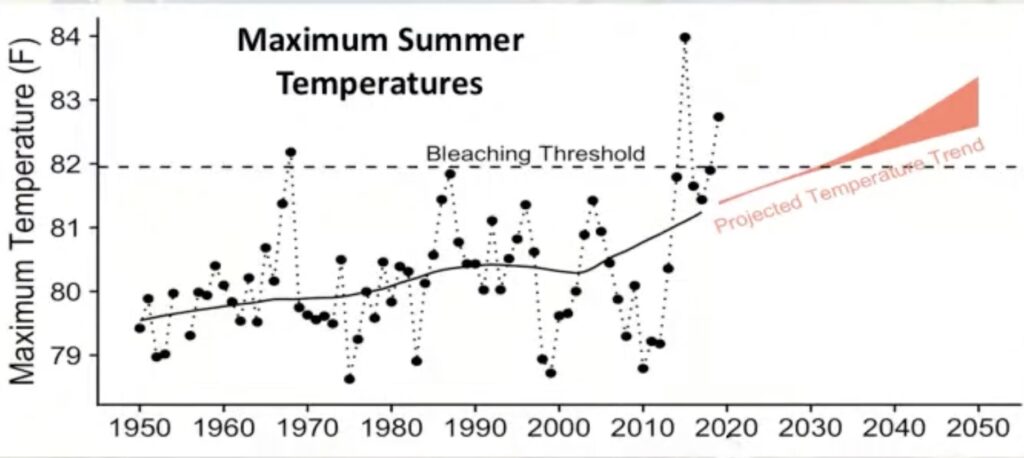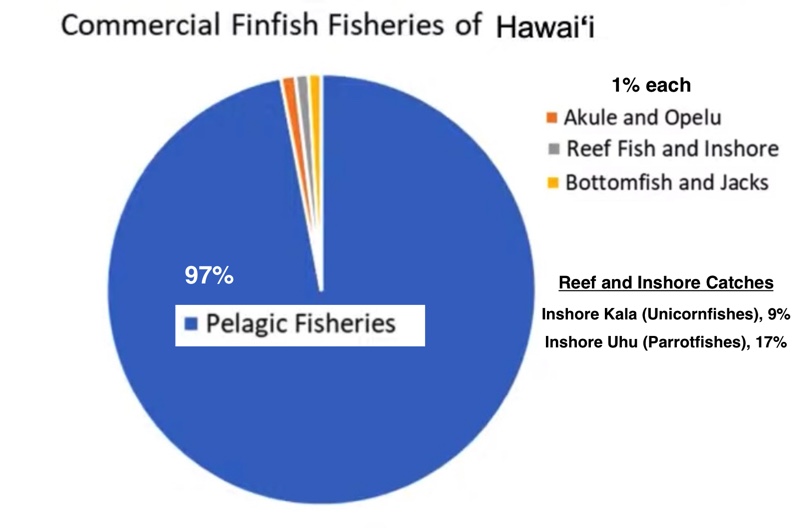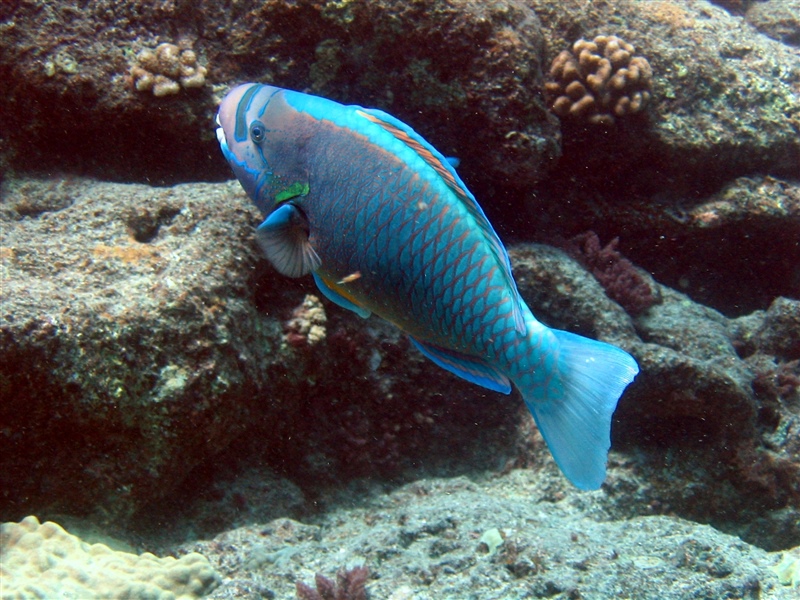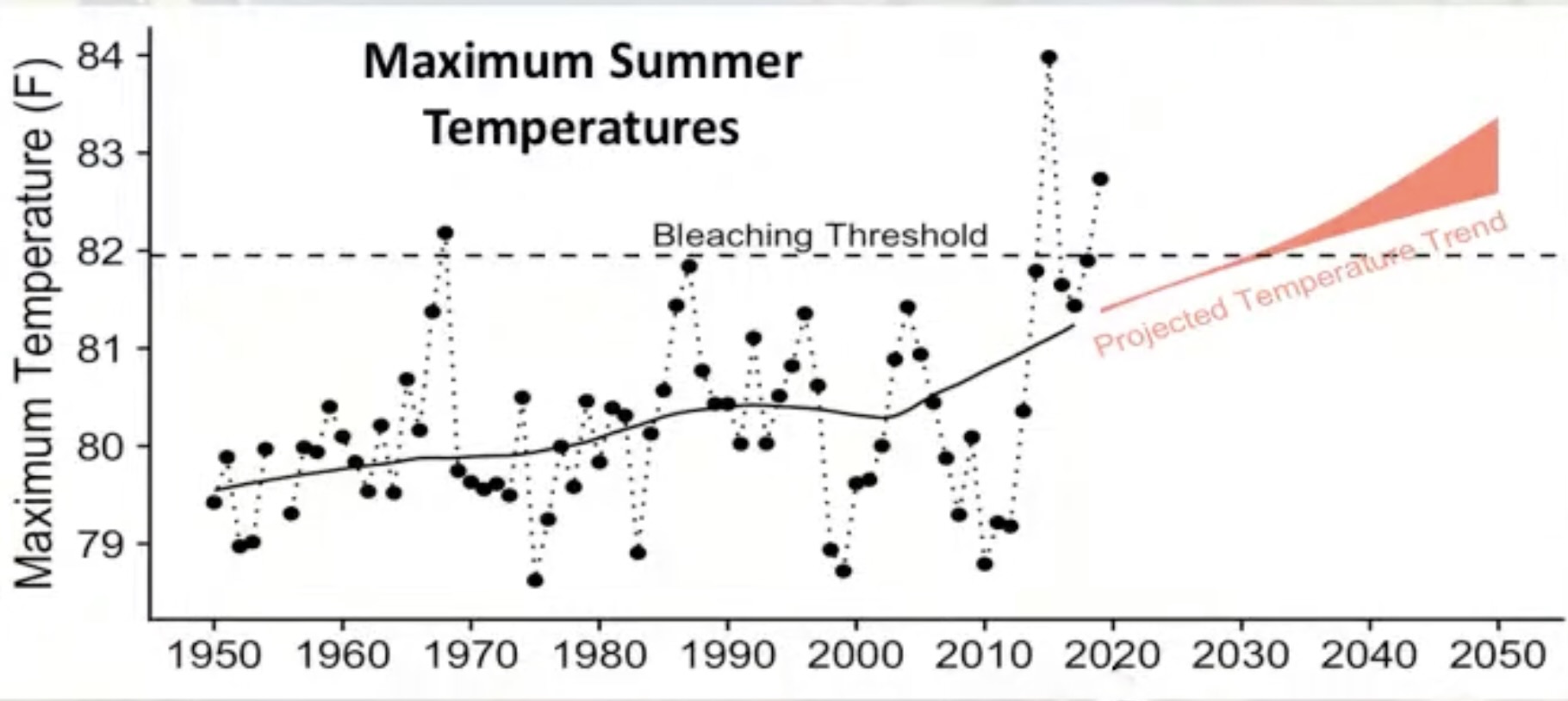After holding 19 scoping meetings that reached more than 500 members of the public, the state Division of Aquatic Resources last month presented to the Board of Land and Natural Resources proposed rule amendments aimed at protecting herbivore species that are critical to helping coral reefs survive the impending increase in ocean temperatures.
At the board’s December 8 meeting, DAR asked that the Land Board authorize the holding of public hearings on the rules package. Testimony from several commercial fishers, however, persuaded the board to hold off so that the division could include some accommodations to allow commercial fishing to continue, but not expand.
DAR recommended increasing the minimum size for manini (convict tang), establishing a minimum size for kole (goldring surgeonfish), establishing a bag limit for kala (bluespine unicornfish), updating uhu (parrotfish) regulations to mirror those for Maui, allowing the take of female papa‘i kualoa (Kona crab) without eggs, and extending the crab’s closed season by one month to better protect females with eggs.
Russell Sparks, an aquatic biologist with the DAR Maui office, explained that while coral reefs have many stressors — pollution, sedimentation, fishing pressure — the bigger concern is global warming.
Hawai‘i reefs experienced mass coral bleaching events in 2014, 2015, and 2019. Although bleached corals can recover, regaining those cells that are expelled when ocean temperatures get too high, they will die if the bleaching event persists, Sparks said.
In 2015, Hawai‘i island lost more than 60 percent of its coral at some reefs. Others on Maui lost 40 to 50 percent of their coral, he said.
Before these events, ocean temperatures exceeded those that corals can tolerate just once, in the late 1960s, and only for a very short period, he continued. Given current temperature projections, “by the year 2030, we expect to exceed the coral bleaching threshold every year,” he said. “If we don’t do things now to reduce stress on our reefs and help corals adapt and adjust to this changing environment, we will lose significant portions of our coral reefs that we depend on for our way of life here in Hawai‘i, and that’s where the herbivore story plays in.”

He explained that while herbivores don’t prevent corals from bleaching or bleached corals from dying, they do keep those spaces that open up after corals die free from invasive algae. With those spaces clear, corals that were better able to survive high temperatures will colonize them, he said.
Studies of Hawai‘i’s reef fish found that a handful of them have a spawning potential ratio far below 30 percent, which is a level at which species are considered to be overfished. Kala, for example, has an SPR of three percent; parrotfish species have an SPR of 2.3-2.6 percent.
Among other things, DAR’s proposed rule changes would protect the fish until they’re old enough to reproduce and would also maintain a social structure for uhu that is most beneficial to the reef.
The greatest sticking point was the proposed bag limit — two per person per day — for kala and uhu, which are targeted by commercial fishers. Maui already has a two fish bag limit for uhu.
Sparks said that DAR understood that the limits would effectively end commercial fishing for these species, but, he added, since 1998 the Department of Land and Natural Resources has had a policy that prioritizes the needs of natural and cultural resources, then those of the general public, and lastly, those of commercial uses.
He also reported that the uhu catch restrictions adopted for Maui several years ago have already yielded some positive results.
Because the fish are fairly slow-growing and long-lived, huge changes aren’t expected to happen quickly, he said. Even so, “we did see an increase in terminal-phase males after the rules. That happened quickly. … in five years,” he said.
The proposed rules would prohibit the take of terminal phase males because they maintain an important social structure on the reef, he said.
He also reported that there was a clear increase in uhu biomass that he believes is attributable to a surge in recruitment in 2014-2015.
“What we don’t have time yet is to see if that increase sustains itself in the open areas or drops back down,” he said, adding, “It’s going to take the ecosystem longer to respond and us longer to measure that change.”
DAR aquatic biologist Bryan Ishida pointed out that the kala and uhu commercial fisheries make up a fraction of one percent of the revenues generated by the state’s commercial finfish fisheries.
Charts he presented showed that the number of participants in the fisheries have declined significantly over the years. Between 2012 and 2021, the number of licensed kala fishermen has gone from more than 60 to fewer than 30; the number of commercial uhu fishermen dropped from more than 100 to about 45.
The kala fishermen earned a little over $30,000 for their catch last year, while the uhu fishermen earned just under $150,000.

Some commercial food fishers who testified before the board questioned the data on fish abundance, arguing that scientists were simply looking in the wrong places. Others tried to shift the blame for low fish populations on competition from invasive fish species or threatened green sea turtles or predation by endangered monk seals. One testifier suggested that the state focus on creating artificial reefs like those in Florida and Japan, arguing that the tweaks to catch limits aren’t going to do anything.
Kim Koch, representing the West Hawai‘i Aquarium Fishery, added that the population of kole in West Hawai‘i is healthy and recommended exempting it from the proposed minimum size limit of five inches.
Commercial fishers weren’t the only ones worried that the proposed bag limits were too restrictive. Subsistence fisherman and hunter James Manaku, Sr., told the board he was glad that steps were being taken to ensure that fish will be available for future generations. However, he said he didn’t think his family would be able to survive if he was limited to catching two uhu or kala a day. “I don’t want to see my family starving,” he said.
After giving DAR staff a day to brainstorm some accommodations for the few dozen active commercial kala and uhu fishers, the board ultimately decided to defer taking action on the rules package. DAR had come up with some ideas: new daily bag limits for kala and uhu, seasonal closures, provisions allowing for more kole catches by aquarium fishers, as well as a control date that would cap the number of commercial fishers to those who possessed state licenses at the time the rules are adopted. However, because those options were not publicly noticed, the board could not act on them that day.
DAR administrator Brian Neilson said that his division could bring back a revised rules package that included these proposed changes within four months or so.
While all of the board members were eager to get a package that would allow some commercial fishing to continue, then-board chair Suzanne Case cautioned them against expecting a solution that everybody agrees with. As she reminded the board during its debate the previous day, “These are just hard choices. Our fisheries are going down. Our corals are going down. We have, compared to a lot other places in the world, very loose rules. The fact that they’re going down is our responsibility. … If your hard choice is not in favor of protection of the resource, nobody benefits. The whole purpose of these kinds of limits is to increase the fish population for everybody.”
— Teresa Dawson



Leave a Reply